The current state of marketing agencies
We still see a significant gap between agencies that are only data-aware and those that embrace data-driven methodologies. Simply collecting large amounts of data isn’t enough to call yourself data-driven; It requires integrating that data into your agency’s processes, strategies, and client interactions.
In this article, we’ll explore the essential pillars of a data-driven marketing agency and discuss its benefits. But first, let’s address the differences, challenges, and real costs of not adopting a data-driven model.
Traditional approaches vs. data-driven methods
Traditional digital marketing relies on instinct, general trends, and one-size-fits-all approaches that often fail to resonate with specific audience segments.
Campaigns are built on broad target audiences, such as “small business owners” and basic demographics, which often fail to perform.
In comparison, data-driven marketing focuses on building granular audiences based on behavioral analytics collected across multiple data sources and using it for targeted campaigns that utilize real-time customer data.
These personalized user experiences result in specific targeting, higher engagement, and improved conversion rates.
There’s another key difference in the way these two approaches impact operations.
Traditional marketing agencies launch a campaign, wait a month, analyze one-time reports, and make adjustments. The reports are built on isolated metrics from different platforms, making it difficult to understand the big picture. By the time the changes are implemented, valuable optimization opportunities may have been missed.
Data-driven marketing agencies track campaign performance by automatically collecting and blending data from all channels into unified live dashboards. This approach allows you to:
- Monitor conversion paths in real-time to identify and fix issues.
- Adjust marketing campaigns as you go.
- Properly track and attribute results across the customer journey.
For example, having a report based on the data from GSC and GA4 allows a data-driven agency to spot when a landing page conversion rate drops. As a result, it can analyze user behavior recordings to identify and fix issues before losing money invested in an underperforming campaign. Coupler.io allows you to easily create such reports and even provides them out-of-the-box, like this landing page performance dashboard.
Landing page performance dashboard in Looker Studio
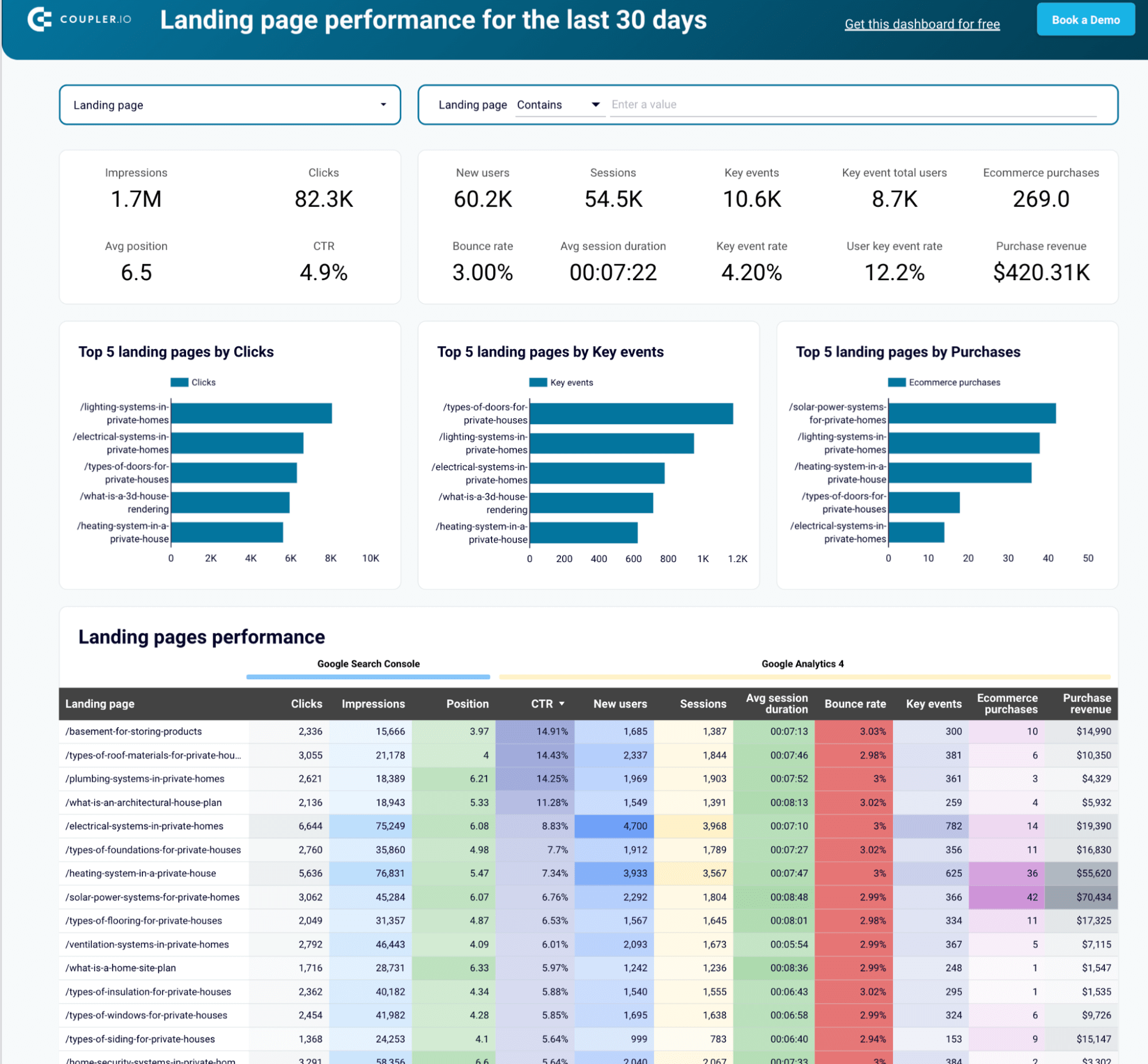 Preview dashboard
Preview dashboard
Landing page performance dashboard in Looker Studio
Preview dashboardKey pain points in data collection and analysis
Most marketing agencies understand the need to become data-driven, but the move is often delayed due to implementation challenges. Key pain points include:
- Data silos: Fragmented data sources across disconnected marketing platforms make it harder to analyze the complete customer journey. Data is spread everywhere, from ad platforms to CRM systems, while different naming conventions make it a challenge to blend.
- Data quality: Incomplete and inconsistent tracking, duplicate records, and outdated data lead to unreliable insights and bad decision-making. These results can make you think that being data-driven is not the answer.
- Lack of expertise: Many agencies lack the skills and knowledge to collect, analyze, and transform data into actionable insights.
- Privacy regulations and tracking limitations: With regulations in place and the cookie era coming to an end, marketing analytics are more challenging to collect at a granular level.
The cost of not being data-driven
Although the challenges of shifting to a data-driven approach can seem daunting, the cost of not doing it should serve as a motivating factor:
- Inefficient marketing spend: You risk wasting resources on campaigns that don’t resonate with your target audience.
- Missed opportunities: Failing to identify patterns and issues in real-time.
- Lower campaign ROI: Not generating enough ROI for your clients.
- Client churn: Losing clients to data-driven agencies that deliver better results.
What is a data-driven agency?
A data-driven marketing agency collects and transforms raw data into actionable insights, using this information to guide and influence decisions about marketing campaigns. It’s all about leveraging data to validate hypotheses, optimize campaigns, and understand ROI.
Consider Ronald Coase’s famous quote:
If you torture data long enough, it will confess to anything…
Three core pillars of data-driven agencies
- Real-time performance monitoring using dashboards: Track key metrics on the go, so you can respond to opportunities and adjust campaigns promptly. For example, when your dashboard shows LinkedIn posts on Tuesday drive 2x more leads, you can optimize right then and there instead of waiting for the monthly report.
- Reports for clients and internal activities: Create reports that tell stories, not just display numbers. For example, instead of saying, “Organic traffic decreases by 15% in January 2025 compared to September 2024,” client reports should also explain the narrative behind it – “We’re seeing a 15% decrease in organic traffic due to an increase in referral traffic where we have been driving most activities as part of our 2025 new strategy to increase revenue by expanding partnerships and referral programs”.
With Coupler.io, you can easily create cross-channel marketing analytics reports since it allows you to transform scattered data from Google Analytics, social media platforms, and advertising accounts into a unified performance story. Here is an example of such a report for web analytics.
Web analytics dashboard in Looker Studio
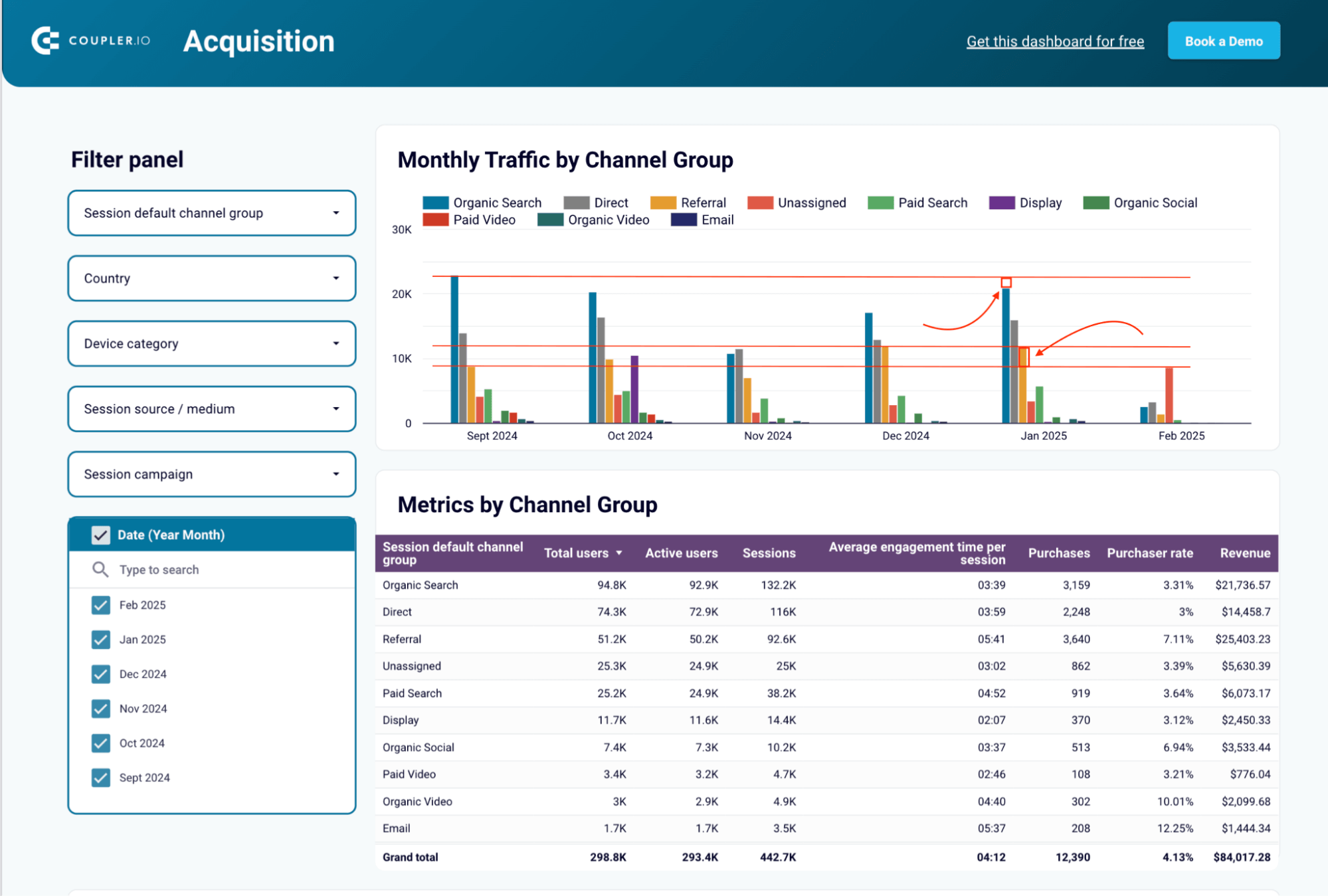 Preview dashboard
Preview dashboard
Web analytics dashboard in Looker Studio
Preview dashboard- Automated systems for data collection and transformation: Use tools to put it all together. Whether you’re using spreadsheets, Looker Studio, or enterprise platforms, focus on automated data collection and consistent KPI tracking. The key is making your data accurate, accessible, and actionable.
Implementing these pillars will help your agency focus on data-driven marketing strategies by:
- Monitoring and understanding customer behavior and how campaigns perform in real-time.
- Tracking progress towards key performance indicators (KPIs) and business objectives.
- Generating insights that inform strategic decisions and drive continuous improvement.
- Reducing routine and error-prone tasks using automated processes.
Foundation of a data-driven marketing agency
We’ve mentioned the three core pillars of a data-driven marketing agency. However, building performance dashboards and reports comes after understanding what needs to be tracked and measured.
Let’s look at what metrics marketing teams should monitor inside the dashboards and where you can get the data.
Essential metrics and KPIs to track
As a data-driven agency, you can make better marketing decisions when you track a range of metrics and KPIs, including:
- Website traffic and engagement: Organic vs. paid traffic growth, page views, the exit rate of key pages, engagement rate, and conversion rates. These will tell you how your search engine optimization (SEO) and content marketing campaigns are performing.
- Lead generation: Number of marketing qualified leads, cost per lead, and lead quality through MQL to SQL conversion rate to better understand customer acquisition.
- Social media performance: Reach, engagement rate, follower growth, ad cost, and content conversion rate to understand which campaigns, creatives, and messages drive the best results.
- Email marketing performance: Open rates, click-through rates, and conversion rates to understand email campaigns’ impact at different touchpoints.
- Revenue metrics: Campaign return on investment (ROI), customer acquisition cost (CAC), and customer lifetime value (LTV) to demonstrate marketing effectiveness and optimize budget allocation across channels. ROI is the ultimate measure of access for any marketing agency’s efforts. It directly shows clients the value of their investment in clear financial terms.
Data sources marketing agencies should monitor
A data-driven marketing agency should leverage data from multiple sources to get actionable real-time insights. These sources include:
| Data source | Why it matters | Platforms |
|---|---|---|
| Website data analytics | Track website traffic, audience behavior, and campaign performance. | Google Analytics 4, Google Search Console |
| Social media platforms | Monitor social media post engagement and brand growth | Meta, X, TikTok |
| Paid Ad platforms | Understand PPC campaigns and report on performance | Google Ads, Meta Ads, LinkedIn Ads, Quora Ads, YouTube Ads |
| CRM systems | Analyze the customer journey with marketing funnel analytics and track the sales pipeline | HubSpot, Salesforce, Pipedrive |
| Email marketing automation tools | Track email campaign results and how they impact conversions | Mailchimp, ActiveCampaign, Brevo |
| Data warehouses | Import large data sets and transform them for easier reporting in data visualization tools | Google BigQuery |
| Behavioral analytics tools | Understand customer behavior and what drives conversions | Mixpanel, Amplitude |
Implementing data integration with Coupler.io
After understanding the key metrics and data sources your marketing agency needs, the next step is to integrate the data and build dashboards for data visualization and insightful data analysis.
Coupler.io can help collect, transform, and visualize your marketing data.
Consider how much time your team spends importing data from multiple platforms and creating client reports. On average, a client monthly report requires 5 hours to prepare, while more complex reports can take over 8 hours. That’s because, in most cases, marketing experts manually build these reports using data from multiple sources.
With Coupler.io, you can automate this process and get a unified view of the data for each client. It’s a data automation platform that enables marketing agencies to create scheduled data flows and transform data into reports.
- Make data-driven decisions: By pulling data from your advertising platforms, CRM systems, and financial and analytics tools, you can track the customer journey and allocate budgets based on performance. It will also help spot and fix issues before they impact your campaigns, enhancing your marketing efforts.
- Automate data flows: Remove human error and manual work by automating your data pipeline for unified views and analysis.
- Build client reports: Communicate results with automated reports instead of spending hours every month updating the data to track campaign performance.
For example, a B2B marketing agency can use Coupler.io to create marketing dashboards that blend data from Google Analytics, Google Search Console, and different ad platforms like Facebook ads, LinkedIn ads, or YouTube ads. These dashboards uncover real-time insights into channel performance and conversion dynamics so you can accurately track performance and optimize budgets.
Data-driven marketing in action: A case study of an automated B2B agency dashboard
Automated dashboards are the best tool to uncover insights.
Let’s explore an example of a data-driven marketing agency reporting dashboard to optimize results and increase client ROI.
Marketing Pot, a marketing agency specializing in SaaS and B2B service companies, was struggling to manually pull data and build reports for their clients. They were seeking a solution to automate this process and chose Coupler.io.
This partnership enabled them to build a multichannel marketing dashboard in Looker Studio, which automatically collects data from different sources into a single view. As a result, the agency became data-driven and significantly improved reporting for their clients.
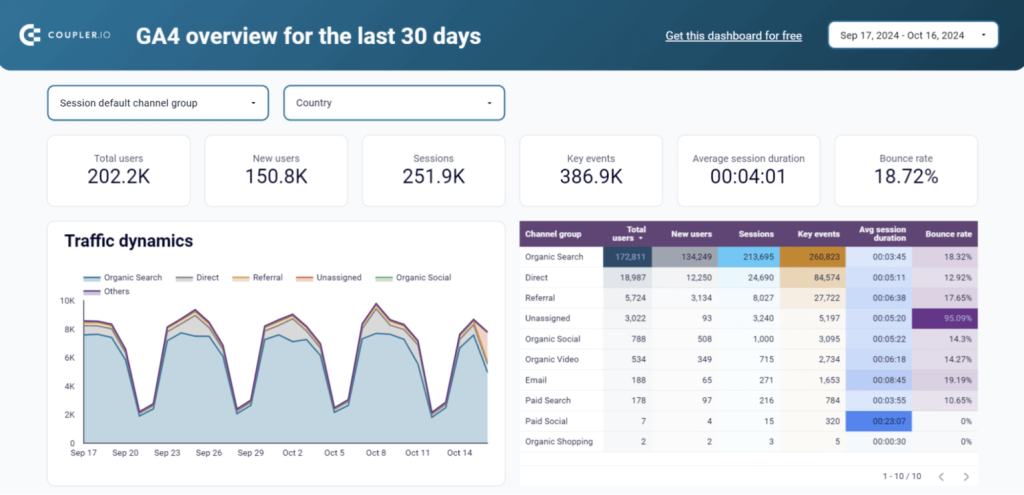
The dashboard consists of four pages that give you a comprehensive view of both organic and paid performance:
- Overview page: Track channel groups and the countries generating traffic, utilizing GA4 data.
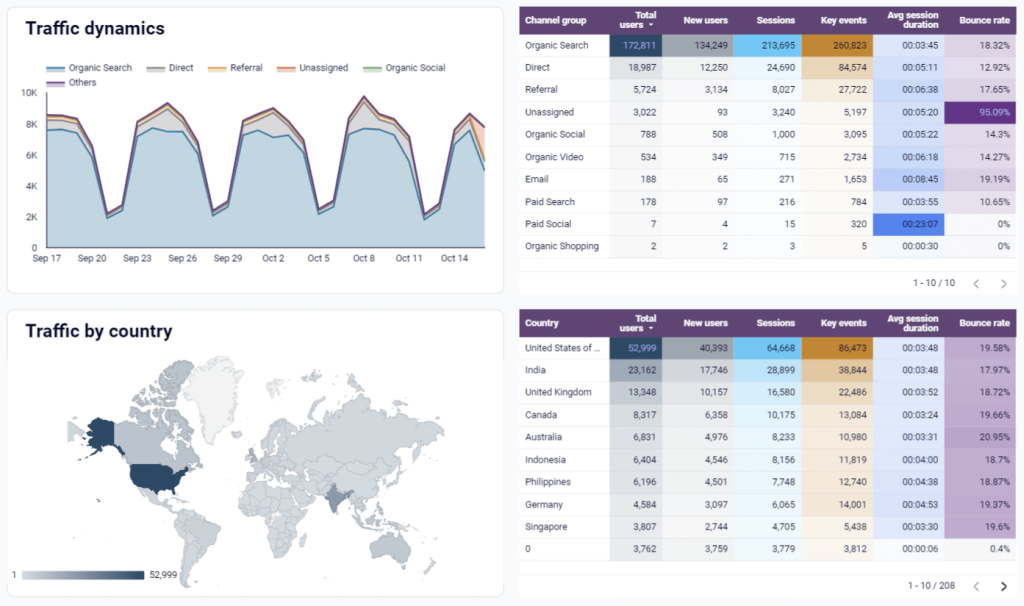
- Landing page performance: Gain a complete picture of each landing page’s performance based on GA4 and GSC data and understand how your SEO efforts impact results.

- Conversions: Understand conversion dynamics and track the customer journey funnel with GA4 data.

- PPC overview: Connect data from Google Ads, Meta Ads, YouTube Ads, and more to monitor paid ad campaigns’ performance and ROI.
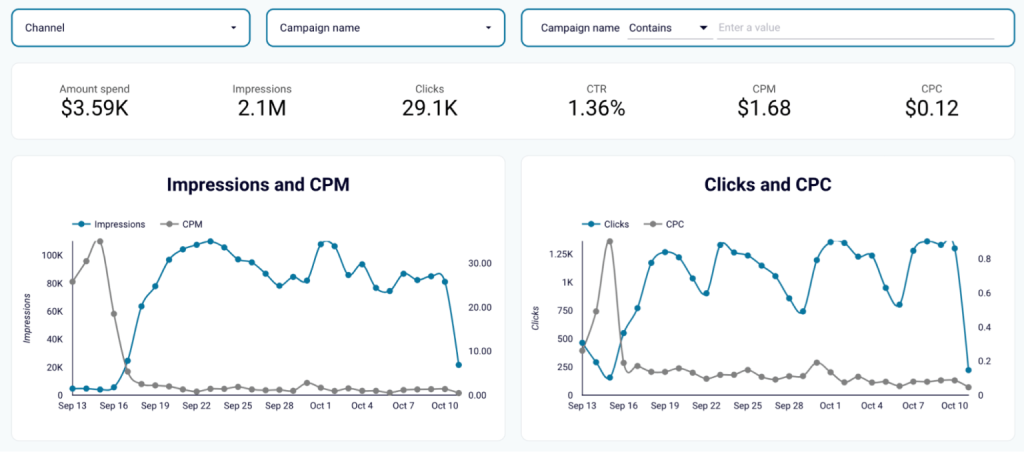
How does the marketing agency dashboard help?
For example, a B2B agency struggled with manual reporting for their client, who received 15,000 monthly website visitors but generated only 2-3 marketing qualified leads (MQLs) each month.
Using this dashboard and Coupler.io, they implemented automated data collection across Google Analytics, Search Console, and various ad platforms. Once operational, they uncovered a critical insight: 60% of their traffic came from non-target countries.
This insight prompted them to redistribute their SEO budget, shifting resources from underperforming landing pages to high-potential focus pages. The result? MQLs tripled within two months while maintaining the same $3,000 monthly budget. This success is due to the real-time visibility into:
- Channel performance by country
- Landing page conversion rates
- Ad spend effectiveness across platforms
- Complete MQL funnel visualization
This B2B marketing dashboard has a custom setup. So, it’s not available as other marketing reporting templates by Coupler.io. You’ll need to connect multiple data sources as separate connectors, including Google Analytics, Google Search Console, and the advertising platforms used. However, Coupler.io’s team of data experts can implement this for any agency, so they can easily use it for each client.
You can also expand the dashboard’s capabilities by adding other data sources. For example, it can provide insights into your specific needs, such as cold outreach data, email marketing, finance data (working hours or additional costs for links), and much more.
Do you want a similar reporting solution?
Book a callBest practices and common pitfalls
Building a data-driven marketing agency requires collecting and processing data at scale for better decision-making. Here are the best practices to implement to avoid common pitfalls.
Data security and privacy considerations
Data security and privacy should never be an afterthought. Adhering to privacy regulations like GDPR and CCPA is the first step in adopting ethical data practices and becoming data-driven.
Create transparent data collection policies and communicate with your clients on how their data is being used. You’ll need to ensure your client data is secure and not used in any harmful way.
Transparency will help build stronger client relationships while complying with data regulations.
You should also consider implementing role-based access controls inside the tools so everyone can access only what they need. This will limit the risk of data falling into the wrong hands.
Avoiding analysis paralysis
With all the platforms digital marketing agencies use, it’s easy to get lost in a sea of metrics and reports. This is called “analysis paralysis”.
To avoid this, focus on metrics that drive actual business decisions. Instead of tracking everything possible, identify the top three to five relevant KPIs for every client.
For example, for an e-commerce client, these would be conversion rate, average order value, and customer acquisition cost. Focus on these, and don’t get distracted by vanity metrics like social media likes.
When building reports and dashboards, place the key information at the top to showcase important metrics while keeping additional data accessible on separate pages. This will make data less overwhelming and give you a clear path to better decisions that impact business goals.
Maintaining data quality
Irrespective of how efficient your digital marketing strategies are, poor data quality will lead to poor results. When the numbers you’re analyzing are not accurate, they will tell the wrong story and lead you to false assumptions and bad decisions.
Start by creating standardized naming conventions for campaigns across all platforms to facilitate consistent tracking and reporting.
Then, audit each client’s data for:
- Data completeness: Is the right data being tracked, and can you access it?
- Data freshness: Are you pulling data in real-time and not relying on old data?
- Data accuracy: Do metrics match across platforms, or are there big discrepancies that might signal improper setup?
Scaling data operations
As your marketing agency grows, your data needs will become more complex. This is why automating processes from an early stage can be beneficial in the long run. You’ll save hundreds of hours on manual work and ensure data accuracy and precision at scale.
Think of automation as the foundation that enables your agency to grow full-service and add more clients without needing more data strategists on your team to handle the data.
Start by identifying repetitive tasks that consume your team’s bandwidth, such as client reporting. Tools like Coupler.io can automatically pull data from multiple sources, update your dashboards, and generate client-ready reports, freeing your team to focus on strategy and optimization.
You should also consider automating alerts for campaign spikes and data quality issues or monitoring hitting budget limits. For example, when a client’s conversion rate drops by 20%, you want to be notified immediately, not when you’re preparing next week’s report. This way you can stay proactive at scale.
Here’s a summary of what you can look at automating to support your agency data operations and business needs at scale:
- Automated data imports to visualize key metrics across real-time dashboards.
- Data validation to flag inconsistencies.
- Scheduled data refreshes from all your marketing tools.
- Standardized reports for clients.
- Automatic alerts to track performance and spikes.
By implementing these processes, your digital marketing agency will become entirely data-driven and have a solid foundation to streamline scaling.
Automate marketing agency reporting with Coupler.io
Get started for free



